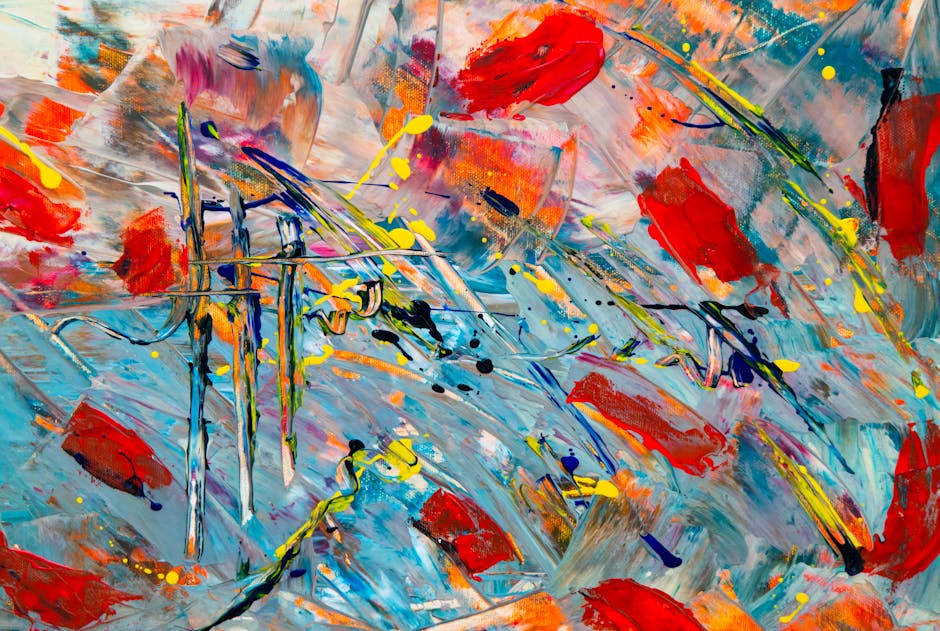Abstract Expressionism’s Titans: Redefining American Art
In the mid-20th century, a group of pioneering artists transformed the American art landscape, making New York City the new global art capital. Their innovations in form, emotion, and technique marked the rise of Abstract Expressionism—an art movement that broke rules, evoked raw emotion, and demanded active engagement.
Jackson Pollock and the Power of the Drip
Jackson Pollock revolutionized painting with his signature “drip” technique. Rather than using traditional brushes and easels, he placed canvases on the floor and poured, flung, or dripped paint from above—an explosive departure from conventional methods.
- Action painting: Painting became a physical act of movement and energy
- Materials and methods: Used industrial paints, sticks, and trowels
- Philosophy: Embraced chaos, spontaneity, and the unconscious mind
His dynamic surfaces, full of gesture and rhythm, forced viewers to experience painting as a process rather than a finished product.
Rothko’s Emotional Color Fields
Mark Rothko approached abstraction from an emotional lens. His works feature large, soft-edged rectangles of color meant to evoke introspection, stillness, and spirituality.
- Simplified composition: Horizontal bands of color floating on canvas
- Emotional intensity: Aimed to stir deep, often meditative emotional reactions
- Immersive viewing: Works are best experienced up close, inviting contemplation
Rothko’s colors weren’t just aesthetic choices—they were emotional landscapes intended to connect with something primal in the human experience.
De Kooning: Between the Human and the Abstract
Willem de Kooning took a different path, fusing abstract elements with distorted human forms. His work captured both energy and ambiguity, especially in his series of “Woman” paintings.
- Layered, gestural brushwork: Suggests movement and inner conflict
- Figurative tension: Balanced recognizable figures with abstraction
- Expressive force: His paintings feel both spontaneous and aggressive
De Kooning challenged the boundaries between figuration and abstraction, proving they weren’t mutually exclusive.
How New York Became the New Art Capital
Before World War II, Paris was considered the heart of the art world. But by the 1950s, thanks to these innovators and others,
New York had assumed that title. Several key factors contributed:
- Cultural migration: European artists and intellectuals fled to the U.S. during the war
- Institutional support: American museums and galleries began promoting contemporary work
- Media and market attention: Critics and collectors recognized the significance of the movement
Together, the radical visions of Pollock, Rothko, and de Kooning helped anchor New York as the epicenter of modern art, shifting the global art narrative permanently.
Their legacy? A revolution in how art is made, experienced, and understood.
Before the mid-20th century, Western art had gone through waves of reinvention—each reacting against the last. Realism locked in the visible world with precision. Impressionism broke that grip, chasing feeling and light in loose gestures. Modernism tore down the old rules entirely—shattering form, rethinking content, and leaning into abstraction. But by the end of World War II, these movements had run their course. The world had changed too much for old styles to keep up.
War had left both cultural identity and individual consciousness fractured. Cities were leveled, lives uprooted, and whole generations were reckoning with trauma that didn’t fit traditional narratives. The old visual languages—structured, symbolic, orderly—just didn’t cut it. Artists needed a new way to express raw emotion, psychological depth, and existential weight. Something louder. Looser. More urgent.
This is where the turning point hits. Abstract Expressionism wasn’t just a new style—it was a declaration. These artists poured emotion straight onto the canvas without filtering it through form. No safety nets. No scaffolding. It was messy, immediate, and entirely reflective of the postwar psyche. In that way, it wasn’t just art evolving. It was art becoming survival.
Big picture: it’s not about polish—it’s about pulse. In this space, emotion takes the wheel before precision even buckles in. Vlogging in 2024 channels a core belief that what matters most is feeling something real, not crafting something perfect. Viewers want to be moved, not just impressed.
That’s the philosophy: emotion over form, process over product. The act of creation—the effort, the humanity, the mess—is part of the appeal. Behind-the-scenes peeks, raw edits, vulnerable takes… that’s what’s cutting through.
Visually, there’s a pattern emerging. Not tidy, not slick. Think big gestures, handheld urgency, spontaneous cuts. Scale and imperfection carry weight. Jump-cuts are intentional. Lighting is sometimes brutal. It’s the kind of work that tells you the creator didn’t wait for the right moment—they grabbed the camera and made it one.
And still, it’s not a style you can pin down. It’s a mindset. Whether you’re making quiet nature vlogs or chaotic day-in-the-life montages, the common thread is honesty. If there’s a rulebook, it’s written in pencil—and most are scribbling in the margins.
Modern Art’s Lasting Legacy: Opening the Door to the Postmodern Shift
Modernism didn’t just reshape the art world in its time—it set the stage for dramatic changes that followed.
Influencing New Movements
As Modernist boundaries were pushed, room was made for entirely new genres and questions:
- Minimalism reimagined what art could be by stripping it down to its essentials
- Pop Art blurred the line between high art and mass culture, challenging elitist assumptions
- Performance art turned the act of creating into the art itself, emphasizing experience over product
Shifting the Power Structures
Modernism also transformed the way art was evaluated, collected, and discussed:
- Galleries began to embrace more experimental work
- Critics were forced to reconsider what constituted “serious art”
- Collectors expanded their tastes beyond traditional painting and sculpture
Introducing Postmodern Skepticism
Perhaps most profoundly, the Modernist legacy gave rise to Postmodernism—a movement defined not by new forms, but by questioning meaning itself:
- Irony replaced sincerity
- Authorship became decentralized
- Viewers were encouraged to define meaning on their own terms
For further reading: Key Differences Between Modernism and Postmodernism in Art
Art in recent years has shed its distance. It’s no longer just a canvas or a reel or a performance—it’s a message, a stance, a slice of life from the creator’s gut. In 2024, we’re seeing that shift go even deeper. Vlogging, once about sharing cool experiences, is now a vessel for personal truth, social critique, and identity. Not everyone is chasing virality anymore—some are chasing clarity.
Audiences have changed too. They don’t just consume—they interpret. A vlog about a morning routine can spark debates around capitalism, wellness cultures, or gender roles. A travel diary becomes a commentary on global inequality depending on who’s filming and where. The viewer is part observer, part co-author.
And behind the camera, the “artist as individual” is rising hard. In a fragmented global culture, it’s not faceless brands that stand out—it’s real people with complex stories. Vulnerability, voice, raw perspective: those are the new currencies. The most resonant vloggers are the ones who dare to be fully themselves, and who aren’t afraid to make their content personal—even political.
Abstract Expressionism’s Echo in Modern Creative Work
Abstract Expressionism never really died—it just changed outfits. You can still see its fingerprints all over the work of today’s painters, designers, and even filmmakers. The movement’s emphasis on process over perfection, emotional risk over polish, informs a generation seeking to be real in an age of filters and algorithms. From brushstrokes that feel more like gestures than images, to film sequences that feel more about mood than narrative, the ethos is alive and kicking.
Art schools haven’t let go either. While once it was about making a mark on the New York art scene, now it’s about finding psychological freedom. The radical idea that what you feel matters more than what you show—that’s a thread still being passed down in critiques, studio sessions, and modern MFA programs. Students are pushed not just to draw accurately, but to draw honestly. What Abstract Expressionism fixed into the DNA of art education was this: you don’t need a plan to make meaning.
And here’s why it works now, maybe more than ever. We live in a time of short attention spans, hyper-curation, and nonstop scroll. Abstract Expressionism cuts through that noise. It asks people to stop, feel, and linger—without giving all the answers. Its emotional depth hits at a more human pace. And in a distracted age, that feels like rebellion.
It gave people permission to make—and feel—without limits. Vlogging stripped away the stage lights and scripts, replacing them with raw moments, shaky cams, and unfiltered honesty. Suddenly, you didn’t need a film degree or a studio team. You just needed a message, a point of view, and the nerve to hit record.
That shift didn’t just change art. It rewired culture itself. We started valuing real over polished. Audiences connected more with awkward laughs than perfect lighting. The wall between creator and viewer crumbled, and what came through was emotion—messy, moving, sometimes mundane, but always real. That authenticity bled into fashion, advertising, music, politics. Entire industries now speak a dialect that vloggers helped invent.

 Johner Hazardics brought essential structural and technical support to FLP Emblemable, assisting in the development of its layout, functionality, and user-focused features. His dedication to smooth performance and intuitive design helped the platform grow into a reliable and engaging space for artists and enthusiasts alike.
Johner Hazardics brought essential structural and technical support to FLP Emblemable, assisting in the development of its layout, functionality, and user-focused features. His dedication to smooth performance and intuitive design helped the platform grow into a reliable and engaging space for artists and enthusiasts alike.